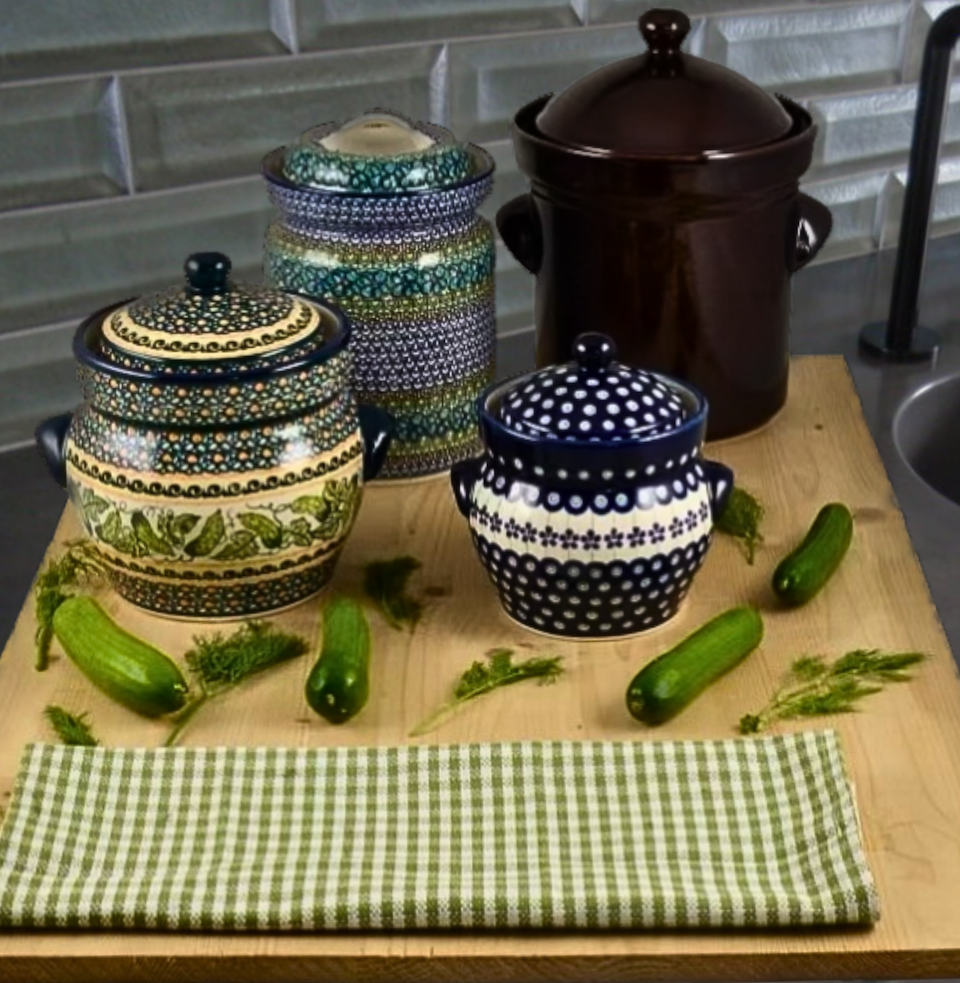
Unlock the Magic of Fermented Foods with Polish Pottery
In recent times, fermented foods have surged in popularity due to their enticing flavors and remarkable health benefits. This ancient preservation technique not only extends the shelf life of your garden's bounty but also enhances their nutritional content. That's why investing in a stoneware crock, like those from Poland, could be your gateway to a healthier and more sustainable lifestyle. Not only do these crocks look stunning on your kitchen counter, but they also yield incredible results, from simple pickle recipes to complex dishes like kimchi.
Fermentation Crock: Your Key to Healthier Eating
Fermentation crocks, those specialized ceramic vessels, play a crucial role in controlled vegetable decomposition, safeguarding your produce from spoilage while amplifying their nutritional value. These crocks feature a unique water-filled gutter in the rim, keeping air out and thwarting the growth of surface molds or yeasts that can spoil your fermenting vegetables.
The Perks of Fermented Foods
Before we dive into how to use a crock, let's explore why incorporating fermented foods into your diet is so worthwhile:
-
Enhanced Nutritional Content: Fermentation significantly elevates the nutritional value of vegetables by fostering the growth of beneficial bacteria like lactobacillus. These microorganisms produce vitamins, enzymes, and bioactive compounds, rendering fermented foods more digestible and nutrient-rich.
-
Probiotic Powerhouse: Fermented foods are natural sources of probiotics, those friendly bacteria essential for a healthy gut microbiome. A balanced gut microbiome promotes better digestion, improved immune function, and overall mental well-being.
-
Preservation Without Preservatives: Fermentation naturally preserves vegetables, eliminating the need for chemical additives. This extends shelf life while reducing food waste.
Choosing Your Brine and Air-Tight Jar
Selecting the right brine and an air-tight jar is as crucial to the fermentation process as using the crock itself. Both create an environment where beneficial microorganisms thrive while inhibiting harmful bacteria's growth. Most countertop crocks establish an air-tight seal by using a lid that, when placed atop the jar in a water-filled trough, blocks outside oxygen while allowing fermenting gases to escape gently. Some even include weights to keep vegetables submerged in the brine, vital for uniform texture and flavor, especially in pickled sauerkraut or kimchi.
So, which should you use — a salt brine or vinegar? Both have their merits and applications:
Salt: Salt is the traditional choice for creating a brine. It enhances the ferment's flavor and encourages the growth of beneficial bacteria. The salt concentration can vary, but a common ratio is one to three tablespoons of salt per quart of water, depending on your taste.
Vinegar: Vinegar can also be used in fermentation, either as a flavor enhancer or the primary fermenting agent. However, vinegar ferments involve acetic acid bacteria and impart a different taste compared to lacto-fermentation, which relies on lactic acid bacteria. Some enjoy the tangy notes that vinegar brings, but it's essential to note that it might not offer the same probiotic benefits as a salt-based ferment. When using vinegar, it's common to add sugar for balance.
Easiest Foods to Ferment and Their Wait Times
For newcomers to fermentation, starting with simple foods is key. Chop or shred your favorite vegetables, submerge them in a brine within an air-tight jar, and wait! The fermentation duration varies depending on your taste and the food being fermented. Keep in mind that the finer you chop or shred your vegetables, the faster they will ferment. Here are some examples:
-
Carrot Sticks: Chop carrots into sticks, create a brine with salt and water, and submerge the carrots for a week to enjoy a crisp and tangy snack in about 1 to 2 weeks. For a milder flavor, add a tiny pepper, but be cautious – the longer you let your carrots ferment, the spicier they become.
-
Pickles: Slice cucumbers, prepare a saltwater brine, add spices and garlic, and let the flavors develop over 2 to 4 weeks for the ideal pickle tang. Homemade pickles are a delightful addition to various dishes.
-
Sauerkraut: Shred cabbage, sprinkle with salt, and let it sit for at least 2 to 4 weeks to ferment. The cabbage releases its brine as it wilts, creating the perfect environment for fermentation. You can allow these flavors to continue developing for months, resulting in tangy sauerkraut to complement your meals.
The essence of fermentation lies in experimenting with spices and wait times to find your preferred flavor. This method of preparing food not only provides more control over what goes into your body but also instills a sense of pride in the process. Happy fermenting and happy eating!

